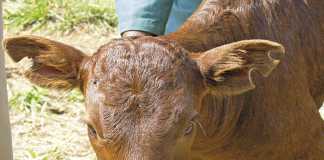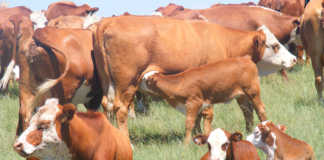Internal parasites
Due to drier weather conditions in large areas of the country problems with internal parasites have decreased. For parasites to thrive, moisture and warm weather conditions are needed.
- Roundworms: Reports of wireworm, brown stomach-worm and other worms were received from most provinces. Consult your vet about selecting the correct anthelmintic group as anthelmintic resistance is rife. Resistance to groups differ from farm to farm.
- Tapeworms: Young animals should be watched for clinical signs such as diarrhoea and pot belly. See if animals are shedding white segments (proglottids) in the faeces. Remember animals become infected when they eat infected grass mites and are not infected via their mother’s milk or some other way.
- Parafilaria: Cattle with bleeding spots were reported from Limpopo, North West, Free State and KwaZulu-Natal. At slaughter these lesions will be removed and farmers will lose revenue. Animals should be treated 70 days before slaughter to allow the lesions to heal.
- Flukes: Study reports from abattoirs to see whether animals slaughtered were infested with liver fluke and discuss control measures with your vet. There is also a blood test available to establish whether an animal is infected with liver fluke.
Be on the lookout for animals with profuse diarrhoea after being moved to camps where there are wet vleis or dams where the infected water snails (hosts) are present.
- Cysticercosis (measles): Farmers should strive to prevent infection of animals, as great losses occur when carcasses are condemned or degraded at abattoirs.
- Coccidiosis: Infections were reported from most provinces. Young animals are especially at risk. Wet and muddy conditions are an ideal place for young animals to become infected with this parasite. Discuss preventative measures with your vet.
External parasites
- Ticks: Blue ticks cause anaemia and transmit African and Asiatic red water, anaplasmosis and lumpy skin disease. Reports of these ticks were received from all provinces except the Northern Cape. Assess the efficacy of control programmes with your vet.
Bont and bont-legged ticks have long mouth parts which cause extensive hide damage. If these wounds are not treated timeously, death may occur. The bont or heartwater tick transmits heartwater and the toxin of the bont-legged tick causes sweating sickness. When these ticks attach between the claws of animals lameness may result.
Hundreds of brown ear-ticks attached to the ears are a common sight this time of the year. If ears are not treated regularly animals may lose ears and even die of tick toxicosis. These ticks can also transmit Theileria, the cause of Corridor disease.
Discuss the life cycles of these ticks and how to control them with your vet, keeping in mind tick resistance. Engorged blue ticks can be collected and tested for resistance. Do not use a homemade pour-on as this is a sure way of selecting for tick resistance and having residues in the meat.
Actives that are used to control ticks are: organophosphates, amidines, pyrethroids, tick development inhibitors (fluazuron) and, for blue ticks, the macrocyclic lactones.
- Lice: Numbers of sucking and biting lice are decreasing. Farmers with wool sheep should check their sheep regularly for lice as they cause serious disturbance of the fleece. There is serious red lice resistance to drugs and therefore farmers should be aware of buying in sheep with lice.
- Mites: Be on the lookout for disturbances in wool and report these to the State Vet as required by law. Sheep scab is a state-controlled disease. Biosecurity measures to prevent sheep becoming infected should be in place at all times.
- Flies, midges and mosquitoes: Numerous reports of nuisance flies, blowflies, screw-worm and nasal bot were received. Be on the lookout for diseases carried by these insects.
Tick-borne diseases
- African and Asiatic red water: Serious losses were reported from many provinces. In most cases the remaining animals were blocked treated with drugs to prevent further deaths. Discuss vaccination programmes with your vet. Asiatic red water is a killer disease and proper steps should be taken to control this it.
- Anaplasmosis: Numerous reports of outbreaks were received from most provinces. This disease is spread by blue ticks, biting flies and needles (vaccinations).
- Heartwater: Causes serious problems in areas where the bont tick is prevalent. Farmers are looking forward to the day when a safe heartwater vaccine is registered.
Insect-transmitted diseases
- Lumpy skin disease: Incidences were reported from all over the country. As vaccines are available to control this disease one can only wonder why vaccination programmes are not followed? Emphasis should be put on training programmes for communal farmers.
- Three day stiff sickness: Vaccine is not available and serious losses were recorded.
- Blue tongue: Reports were received from all over the country except Limpopo. Due to the unavailability of vaccine, young unvaccinated sheep were especially hard hit.
- Rift Valley Fever and Wesselsbron disease: A suspected Rift Valley fever case turned out to be negative. A positive case of Wesselsbron disease was reported from Howick, KZN.
Venereal diseases
Only a few bulls were tested for venereal diseases during this time of the year as they are in with the cows. It is of utmost importance that biosecurity measures are in place.
Bacterial diseases
The following bacterial diseases were reported: blackquarter, pulpy kidney, lamb dysentery, swelled head, red gut, blood gut, tetanus, salmonellosis, enzootic abortion, colibacillosis, lumpy wool and senkobo disease.
Viral diseases
The following viral diseases were reported: Bovine malignant catarrh (snotsiekte), infectious bovine rhinotracheitis (IBR), bovine viral diarrhoea (BVD), enzootic bovine leucosis (EBL), jaagsiekte, orf and warts.
Bovine respiratory disease (BRD) was reported from all over the country with high mortality figures.
Poisonings
In drought conditions plant poisonings are usually on the increase as these are green amid the dry grass. The following toxicities were reported: cardiac glycoside, tulip, ink berry (Cestrum), Cynanchum (klimop), facial eczema, dikoor, geeldikkop, Senecio, Lantana, lupins, krimpsiekte, malkop ui (Dipcadi glaucum), blue green algae, prussic acid, mycotoxicosis, organophosphate, ionophor, lead, urea, nitrate and snake bite.
Draw up a protocol with your vet on how to treat these poisonings should it occur on your farm.
Feedlot Report
Sheep feedlots
- Numerous cases of wireworm were reported and some weaker animals arriving at the feedlot were not able to adapt.
Cattle feedlots
- Numerous kraals had outbreaks of lumpy skin disease.
- Numerous kraals still have carcasses infested with measles although the incidence is lower in comparison to other years. The cattle that are positive are mainly from communal areas.
- Anaplasmosis and red water were reported from numerous kraals and background facilities.













